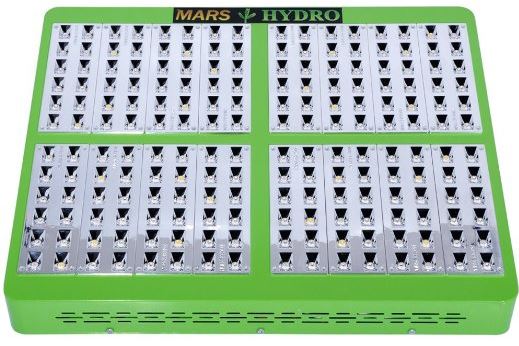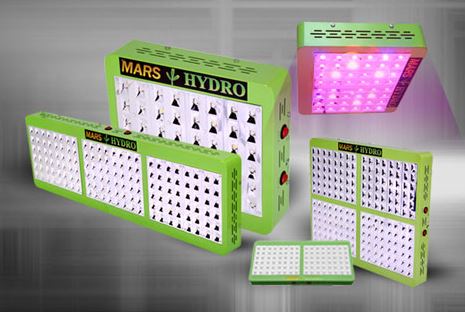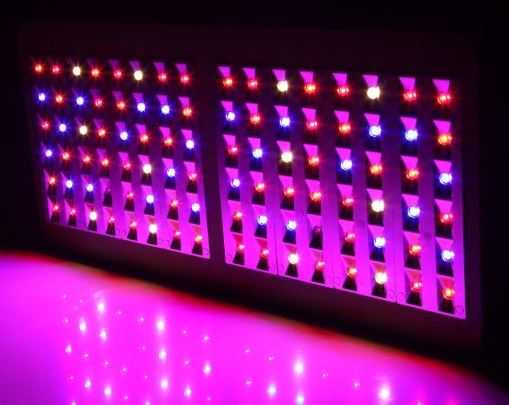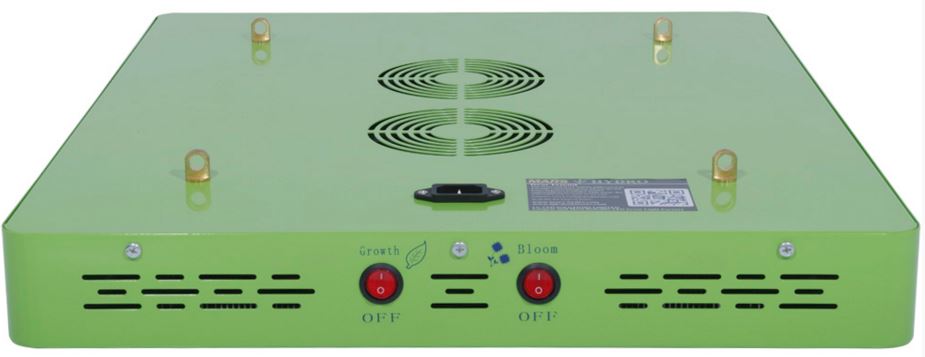Mars Hydro Reflector Series Review (48, 96, 144, 192 LED)
Mars Hydro is known for their budget-friendly LED Grow Lights that are often priced much less than their competitors. One of their most popular in their lineup, the Reflector Series, comes in a wide range of sizes that’s perfect for the value-minded grower. Built with an assortment of 5 watt individual diodes, it comes in four different sizes – 48, 96, 144, or 195, each with a unique reflector panel that has a mirror-like finish to properly reflect and mix the emitting light. We got our hands on a few of these Mars Hydro Reflector Series LEDs to test them out for ourselves and see if they really performed well.
Spectrum
Arguably the most important factor when it comes to selecting the right grow light is the spectrum. If your plants aren’t given a proper and well-balanced spectrum, you may not ever achieve successful results. The Mars Hydro Reflector Series uses ten bands of light in the 430~440nm, 450~475nm 620~630nm, 650~660nm, and white range. There’s also an inclusion of the infrared spectrum at 730nm that’s thrown in for good measure. Keep in mind that the infrared light isn’t visible to the human eye, so if you look at the diodes and notice a few that aren’t lighting up, it’s likely the 730nm infrared.
We feel that this spectrum is everything you could ever need when it comes to all phases of growth. For seedlings, clones, vegging, and blooming, the Reflector Series does a great job providing a well balanced menu of light for the plants. It’s rich in the red range which offers better inter-nodal spacing during the stretching phase of bloom, and has been said to best mimic the late summer sun.

Reflectors
By taking a look at these lights, the first thing you may notice is the large mirror-like reflector that they’re named after. Surrounding each individual diode is a reflector that collects and fuses 99% of the light in order to mix and spread as effectively as possible. It’s a patented system that Mars Hydro has showcased for several years.
Coverage
Since each panel in the Mars Hydro Reflector Series is a completely different size, they don’t all offer the same amount of coverage. Obviously, the more diodes on the panel, the more it’s going to cover, but let’s get down to the specifics.
- Reflector 48: 1.5ft × 1.5ft (0.4m × 0.4m)
- Reflector 96: 2ft x 3ft (60cm x 90cm)
- Reflector 144: 2ft x 4ft (60cm x 122cm)
- Reflector 192: 3.5ft × 3.5ft (106cm × 106cm)
As you can see, the coverage is about standard for what you’d expect a panel of this size to be able to handle. These estimates for growing coverage are given for flowering coverage. They likely will veg just fine in a space that’s slightly larger.
Diodes and Energy Usage
Each different sized panel is given a name with a corresponding number. This number is the amount of individual diodes that the specific panel has. Although the reflector series has been around for a couple of years now, it’s just as of late that Mars Hydro offers all of them with 5 watt Epistar diodes rather than 3 watt diodes. This increase in wattage gives them the ability to emit more light than previously, which is why more growers are seeing a better success with them than their older models.
Although LEDs definitely use less energy than HID or high pressure sodium lamps, it’s still important to understand exactly how much energy they’re going to draw. Since each diode isn’t ever driven to it’s maximum output, they’re designed to last for over 50,000 hours while maintaining overall low energy usage. To get down to specifics, let’s take a look at the amoutn of wattage each panel pulls from the wall outlet.
- Reflector 48: 120V: 102W±5%, 240V: 100.6W±5%
- Reflector 96: 120V:207W±5%, 240V: 203W±5%
- Reflector 144: 120V:317W±5%, 240V: 311W±5%
- Reflector 192: 120V: 410W±5%, 240V: 397W±5%
Switchable Modes
Some LED grow lights are built for a single intensity, and that’s just fine. However, if you’re going to use an LED for seedlings, clones, or younger plants, it might just be a bit too much light. That’s why Mars Hydro incorporated a switchable mode so you can toggle between half of the diodes on, or all of the diodes on. On the side of each panel are two switches that can be flipped in order to turn 50% of it off, or run it at full power. Ideally, full power is the best for the bloom phase, and half power is best for seedlings, clones, and light vegging.
Cooling
Through an 18 hour day, the Mars Hydro Reflector Series seems to do excellent at keeping cool. We’ve even operated it for 7 days straight, and had no issues with it overheating or malfunctioning in any regard. When a proper cooling system has been integrated, this is the result – a panel that can withstand hours of continuous use with the same efficiency as the first hour it starting working.
Internally are larger than average aluminum heatsinks that work in conjunction with large cooling fans that are spinning as long as the light is turned on. This constant airflow offers effective heat dissipation, even in grow rooms that regularly exceed 80 degrees. Additionally, the fans are fairly quiet, making it a perfect option for those who need a less-noisy growing environment.
Overall Thoughts
The Mars Hydro Reflector Series is one of the best performing, budget-friendly grow lights that we’ve seen as of late. Designed with 5 watt diodes with a balanced and rich spectrum, it does a fantastic job at the blooming phase but also excels perfectly with vegging, seedlings, germination, and clones too. We’ve seen hundred of grow journals that have showcased it’s use, and we’re proud to say that we can vogue for it’s effectiveness as well.
Best of all, each Reflector Series LED Grow Light that ships comes included with a 2 year (24 month) warranty period that offers 24 hour assistance if you ever have any issues with your light. We’ve owned ours for roughly 14 months and it’s still running just as strong as when we initially purchased it.









I’ve used Mars Hydro LED’s for over 3 years now, I have the reflector series for vegetative growth, & flowering. I believe that these reflect the light more evenly than the units with a glass panel. Over time the glass panel gets a little bit foggy around the halo of each LED. This blocks part of the ability of the light to reach the plants surface, in my opinion. The reflector series will probably outlast the units with a glass panel due to the better design in heat dissipation, I’ve had issues with the Mars units with glass panels already, ie: LED’s burning out, & control boxes going bad. I own 12 Mars Hydro lights for my garden, all of them will eventually be the reflector series, unless something better comes down the pike that can compete with growth/price point of these units. Since switching to LED’s I’ve seen my costs get cut in half on running my garden, & I’ve eliminated all of my HPS gear gladly…
Hola, tengo la serie 96 reflector, una pregunta, con el interruptor de vegetativo encendido solo prende la mitad del panel, y con el interruptor de floración solamente enciende todo el panel pero una luz de espectros naranjas, si tengo encendido ambos si ya es un color normal para led. Es normal sobre todo que en vegetativo encienda la mitad del panel y la otra permanezca apagada?
What switch is best for growth? do I leave both on or growth until my light cycle changes to a 12 hour cycle for bloom. (Then/or) do I just leave the bloom switch on only?. Little confused. I want max growth.
Thanks
use grow only for veg , then switch bloom on as well for flower
I use jus veg switch for 2 or 3cweeks. Than. At like 5 nodes or week 2 or 3 I’ll introduce to full spec
Are these lights only good for hydroponics?
No 150g dry off 3 plants scrogged in a 2x2x4 platinum p300
No. Any grow medium will work. It’s jus a light source. A highly efficient one at that